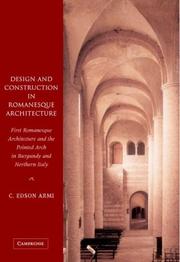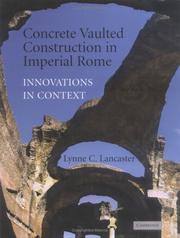| Listing 1 - 3 of 3 |
Sort by
|

ISBN: 0521830338 1107407265 1107148138 0511184425 0511166303 0511313039 0511497709 1280437464 0511164378 051116517X 0511162774 9780511162770 9780511164378 9780521830331 9780511184420 9780511166303 9780511165177 9781280437465 9786610437467 6610437467 Year: 2004 Publisher: Cambridge : Cambridge University Press,
Abstract | Keywords | Export | Availability | Bookmark
 Loading...
Loading...Choose an application
- Reference Manager
- EndNote
- RefWorks (Direct export to RefWorks)
In this 2003 study, Edson Armi offers a fresh interpretation of Romanesque architecture. Armi focuses on buildings in northern Italy, Switzerland, southern France and Catalonia, the regions where Romanesque architecture first appeared around 1000 AD. He integrates the study of medieval structure with an understanding of construction, decoration and articulation in an effort to determine the origins and originality of medieval architecture and the formation of the High Romanesque style, especially in Burgundy, at sites such as Cluny III. Relying on a close analysis of the fabric of key buildings, Armi's in-depth study reveals a lot about design decisions in the early Middle Ages. It also demonstrates that the mature Romanesque of the twelfth century continues many of the applications created and perfected over the previous one hundred years.
Abbayes romanes --- Architecture [Romanesque ] --- Architecture romane --- Architectuur [Romaanse ] --- Cathédrales romanes --- Cloîtres romans --- Romanesque architecture --- Églises romanes --- 72.033.4 <44> --- 72.033.4 <45> --- 624.072.32 --- Architecture, Romanesque --- Architecture, Medieval --- Romaanse bouwkunst--Frankrijk --- Romaanse bouwkunst--Italië --- Arches. Arched beams and girders --- Architecture, Romanesque. --- 624.072.32 Arches. Arched beams and girders --- 72.033.4 <45> Romaanse bouwkunst--Italië --- 72.033.4 <44> Romaanse bouwkunst--Frankrijk --- Arts and Humanities --- Architecture, Fine and Decorative Arts

ISBN: 0521842026 0521744369 1107151554 9786610458691 0511191324 0511161395 0511299834 0511610513 1280458690 0511160119 0511160682 Year: 2005 Publisher: Cambridge : Cambridge University Press,
Abstract | Keywords | Export | Availability | Bookmark
 Loading...
Loading...Choose an application
- Reference Manager
- EndNote
- RefWorks (Direct export to RefWorks)
Concrete Vaulted Construction in Imperial Rome examines methods and techniques that enabled builders to construct some of the most imposing monuments of ancient Rome. Focusing on structurally innovative vaulting and the factors that influenced its advancement, Lynne Lancaster also explores a range of related practices, including lightweight pumice as aggregate, amphoras in vaults, vaulting ribs, metal tie bars, and various techniques of buttressing. She provides the geological background of the local building stones and applies mineralogical analysis to determine material provenance, which in turn suggests trading patterns and land use. Lancaster also examines construction techniques in relation to the social, economic, and political contexts of Rome, in an effort to draw connections between changes in the building industry and the events that shaped Roman society from the early empire to late antiquity. This book was awarded the James R. Wiseman Book Award from the Archaeological Institute of America in 2007.
Vaults (Architecture) --- Concrete domes --- Voûtes --- Dômes en béton --- Design and construction --- History --- Conception et construction --- Histoire --- Rome --- Antiquities --- Antiquités --- 624.072.32 --- 72.032.77 --- 693.5 --- Arches. Arched beams and girders --- Romeinse bouwkunst (tot 476) --- Concrete construction work. Concreting. In-situ concrete. Mass concrete. Reinforced concrete. Prestressed concrete --- 693.5 Concrete construction work. Concreting. In-situ concrete. Mass concrete. Reinforced concrete. Prestressed concrete --- 72.032.77 Romeinse bouwkunst (tot 476) --- 624.072.32 Arches. Arched beams and girders --- Voûtes --- Dômes en béton --- Antiquités --- Roofs --- Domes --- Antiquities. --- To 1500 --- Betonnen koepels --- Design and construction. --- Arts and Humanities --- Architecture, Fine and Decorative Arts

ISBN: 9780521842020 9780511610516 9780521744362 0521842026 0521744369 Year: 2009 Publisher: Cambridge : Cambridge university press,
Abstract | Keywords | Export | Availability | Bookmark
 Loading...
Loading...Choose an application
- Reference Manager
- EndNote
- RefWorks (Direct export to RefWorks)
Vaults (Architecture) --- Concrete domes --- Design and construction --- History --- Rome --- Antiquities --- Antiquities. --- Vaults (Architecture) - Rome - Design and construction - History - to 1500 --- Concrete domes - Rome - Design and construction - History - to 1500 --- Rome - Antiquities --- Voûtes --- Dômes en béton --- Design and construction. --- Conception et construction --- Histoire --- Antiquités --- 624.072.32 --- 693.5 --- 72.032.77 --- 624.072.32 Arches. Arched beams and girders --- Arches. Arched beams and girders --- Roofs --- Domes --- 72.032.77 Romeinse bouwkunst (tot 476) --- Romeinse bouwkunst (tot 476) --- 693.5 Concrete construction work. Concreting. In-situ concrete. Mass concrete. Reinforced concrete. Prestressed concrete --- Concrete construction work. Concreting. In-situ concrete. Mass concrete. Reinforced concrete. Prestressed concrete
| Listing 1 - 3 of 3 |
Sort by
|

 Search
Search Feedback
Feedback About
About Help
Help News
News